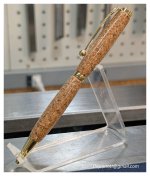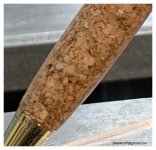Dale Parrott
Member
A local penturner recently asked me if cork could be turned on a lathe. I'd never even considered it but that one question lit a spark. Suddenly, my brain was buzzing, and before I knew it, I was "borrowing" one of my wife's cork trivets and heading to the shop.
Naturally, I asked AI if you could stabilize cork with Cactus Juice. It confidently said no and then followed up with a bunch of technical stuff that sounded like it was meant for a chemistry textbook. I gave it a try anyway. (Spoiler: it didn't work.) But hey, I had to try. It's in my DNA.
The trivet was only 3/8" thick, but I made it work. I saturated the cork with thin CA glue and let it dry, then glued 2 layers together with medium CA. Most of the shaping was done with sandpaper, starting at 60 grit and working my way up like a determined woodpecker.
Now I'm thinking about giving it another go, this time with turning tools, just to see if I can push it a little further. Hope you enjoy the experiment!
Naturally, I asked AI if you could stabilize cork with Cactus Juice. It confidently said no and then followed up with a bunch of technical stuff that sounded like it was meant for a chemistry textbook. I gave it a try anyway. (Spoiler: it didn't work.) But hey, I had to try. It's in my DNA.
The trivet was only 3/8" thick, but I made it work. I saturated the cork with thin CA glue and let it dry, then glued 2 layers together with medium CA. Most of the shaping was done with sandpaper, starting at 60 grit and working my way up like a determined woodpecker.
Now I'm thinking about giving it another go, this time with turning tools, just to see if I can push it a little further. Hope you enjoy the experiment!



